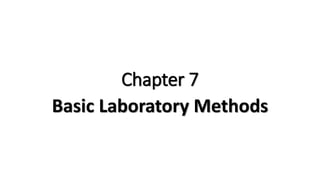
Chapter 7.pptx
- 1. Chapter 7 Basic Laboratory Methods
- 2. 7.1. Culture technique and media • Cultivation of microorganisms requires sterile techniques. by employing aseptic techniques. • Sterilization implies the complete destruction of all unwanted microorganisms including spores. accomplished by the combined usage of most heat, UV light, chemicals, radiation, and filtration.
- 3. Cont. • Microorganisms- grown in either liquid, solid or semi- solid media forms. • Solid media are useful mainly for observations of characteristic colonies, for isolation of pure cultures and for short-term maintenance of cultures. • Cultures usually grow well on agar slopes in test-tubes (also called agar slants) or culture bottles. • e.g. medical fungi grow well on Sabouraud’s medium.
- 4. Cont. • In the laboratory, fungi normally grow on chemically undefined medium. • Commonly used media- Potato Dextrose Agar, Cornmeal Agar, Czapek Agar (CZ) and Malt Extract agar (MA) media • Different fungi prefers different media formulation • Most soil isolated fungi thrive well on Cornmeal Agar (CMA).
- 5. Isolation of fungal strains in pure culture • In natural habitats microorganisms usually grow in complex, mixed populations containing several species. • Common approaches to prepare pure cultures are: pour plate, spread plate, and streak plate. oAfter plates are prepared, they should be incubated.
- 6. Preservation and Storage of Cultures: • Cultures are usually maintained by several methods like sub culturing, under liquid paraffin, by lyophilization and storage under liquid nitrogen,etc. • Refrigeration: Most of the micro-fungi survive at 5-10oC. • Subculturing: serial transfer from staled to fresh solid or liquid media and store in suitable conditions. • Lyophilization: is effected by suspending the metabolic activities of fungi at -70oC. It expensive but needs a very little storing space and cultures remain viable for many years. • Liquid Nitrogen: cultures are preserved in liquid nitrogen (-196oC). • Mineral Oil: cultures under oil for many years give very good results. advantage of putting under the oil is that the mites could not penetrate the layer of the oil.
- 7. 7.2. Microscopy techniques and stains • The direct microscopic examination of specimens is an important first step for several reasons. fungi take days to weeks to grow on agar media, Provide rapid report to the physician, which may allow early treatment to begin. • A number of different stains used to detect and characterize fungi from clinical material. 10%KOH is used for direct examination of specimens, but other methods can be used like: (smear in iodine, Gram stain, Giemsa stain or acid fast stain, silver stain, India ink, etc.)
- 8. 7.3. Specimen collection and Processing and Mushroom Cultivation • Mushrooms are good cash crops; due easy to grow and are rich in protein, vitamins and minerals. Time between spawning and harvesting can be as short as three weeks. after the cultivation, the substrate used as a good soil fertilizer. • In the practice of edible mushroom cultivation no use is made of spores. Their small size makes them difficult to handle and their genetic characteristics may differ from those of their parent. it takes some time for mushroom spores to germinate, whereas other fungi such as green moulds germinate and spread much faster. The desired mushroom must be able to colonize the substrate before other fungi or bacteria do so. :-To achieve this, pre-grown mycelium spawn is used.